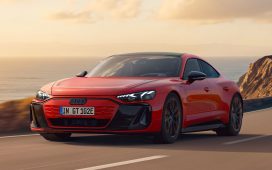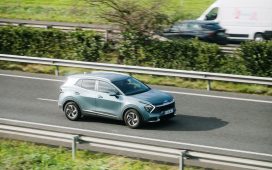The Skoda Octavia is the brand’s best-selling model and it’s getting a mid-life refresh as the nameplate enters its 28th year. It’s now in its fourth generation, and these latest updates apply to both the hatchback and Estate, and concentrate on technology, power hikes, sustainable materials and some gentle styling enhancements. But there’s no sign – yet – of any plug-in power.
On the outside, the familiar shape is lengthened by 9mm on both the hatch and Estate, with new, aero-focused front and rear bumpers. The latest interpretation of the Skoda grille now matches the height of the headlights, which get the latest LED matrix-beam technology. The revised rear lamps get scrolling indicators, plus there are some new wheel designs, while a Sportline trim level – offering a vRS look, but without the performance – joins the range.
Whatever version you go for, you’ll now get a 10-inch digital instrument cluster as standard, with a more detailed Virtual Cockpit available on higher-spec cars. The 10-inch central screen can now be replaced with an optional 13-inch display, and even the USB sockets have been upgraded to USB-C ports with more charging power.
The latest software means quicker reactions for the central screen, more functionality, and a revised layout, while Skoda’s Laura voice assistant – named after one of its founders, Václav Laurin – will soon be boosted by AI-based Chat GPT tech to answer a wider variety of questions. Laura will still take care of the vehicle’s functions, but Chat GPT will provide the answers to a range of more general queries.
Further tech improvements include updates to the Attention and Drowsiness Assist, revisions to the keyless-entry system with proximity sensors to automatically lock and unlock the car as you approach or walk away from it, plus new Park Assist features.
Interior trim on the seats and door panels now use recycled materials, while leather is sustainably treated. Skoda’s ‘Simply Clever’ features also get an eco-makeover, with the famous ice scraper in the fuel flap and the optional umbrella both now made from sustainable materials. An additional storage box is available for rear passengers, while a new, optional luggage cover in the Estate will retract when the boot door is opened.
When it comes to engine options, the 1.0-litre petrol engine has been dropped, leaving two 1.5-litre TSI motors with either 114 or 148bhp; both get the option of mild-hybrid technology to boost efficiency.
Two 2.0-litre petrol and two 2.0-litre diesel engines all get more power. The lower-powered petrol – the only model with four-wheel drive – gets an increase to 201bhp, with the diesels now offering either 114 or 148bhp. There’s no word yet on how these tweaks affect economy or emissions. Seven-speed automatic gearboxes are standard on all models except for the base petrol and diesel cars.
Octavia vRS fans will be delighted to hear that this version also gets a bit more shove (now 262bhp), as well as a sound boost to up excitement levels. The sports exhaust – now with black pipes – has been tweaked, along with new engine software, to produce a ‘more powerful sound’, says Skoda.
The vRS sits 15mm lower than the normal car on sports suspension, while the grille surround, window frames and door mirrors are finished in black. The vRS is the only Octavia to get the latest matrix headlights as standard, while the new 13-inch infotainment screen is also included inside. There’s an updated vRS logo, too.
The revised Octavia line-up, comprising SE Technology, SE L, Sportline and vRS trims, is expected to reach UK showrooms in June. Prices are estimated to start at around £27,000 for the entry-level SE Technology hatchback and circa £28,000 for the Estate.
Plug-in hybrid power set to return?
With plug-in hybrid power available on Octavia-sized cars that share tech with Skoda’s hatch and Estate elsewhere in the Volkswagen Group, we asked Skoda CEO Klaus Zellmer why there was no return for an Octavia PHEV with this facelift.
“At the time it was decided not to put the plug-in hybrid in the Octavia, especially as our main markets are more on the eastern side of Europe where electrification is not that important,” explained Zellmer.
“Will we revisit that? Yes. Looking at the slowing down of the transformation into battery-electric vehicles, while you have CO2 limits, you have to look at your fleet and see whether you have other offers that help you cut your CO2 emissions.
“If people don’t want to go into BEVs, the likelihood – and we can already see that – they will be open for plug-in hybrids is high. However, the profit margins on plug-in hybrids are low.”
Click here for our list of the top 10 best hatchbacks…











